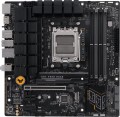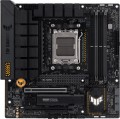Power phases
The number of processor power phases provided on the motherboard.
Very simplistically, phases can be described as electronic blocks of a special design, through which power is supplied to the processor. The task of such blocks is to optimize this power, in particular, to minimize power surges when the load on the processor changes. In general, the more phases, the lower the load on each of them, the more stable the power supply and the more durable the electronics of the board. And the more powerful the CPU and the more cores it has, the more phases it needs; this number increases even more if the processor is planned to be overclocked. For example, for a conventional quad-core chip, only four phases are often enough, and for an overclocked one, at least eight may be needed. It is because of this that powerful processors can have problems when used on inexpensive low-phase motherboards.
Detailed recommendations on choosing the number of phases for specific CPU series and models can be found in special sources (including the documentation for CPU itself). Here we note that with numerous phases on the motherboard (more than 8), some of them can be virtual. To do this, real electronic blocks are supplemented with doublers or even triplers, which, formally, increases the number of phases: for example, 12 claimed phases can represent 6 physical blocks with doublers. However, virtual phases are much inferior to real ones in terms of capabilities — in fact, t...hey are just additions that slightly improve the characteristics of real phases. So, let's say, in our example, it is more correct to speak not about twelve, but only about six (though improved) phases. These nuances must be specified when choosing a motherboard.
M.2 version
The version of the M.2 interface determines both the maximum data transfer rate and the supported devices that can be connected via physical M.2 connectors (see the corresponding paragraph).
The version of the M.2 interface in the specifications of motherboards is usually indicated by the number of connectors themselves and by the PCI-E revision provided for in each of them. For example, the entry “3x4.0” means three connectors capable of supporting PCI-E 4.0; and the designation “2x5.0, 1x4.0” means a trio of connectors, two of which support PCI-E 4.0, and another one supports PCI-E 5.0.
1x PCI-E slots
Number of PCI-E (PCI-Express) 1x slots installed on the motherboard. There are
motherboards for 1 PCI-E 1x slot,
2 PCI-E 1x slots,
3 PCI-E 1x ports and even more.
The PCI Express bus is used to connect various expansion cards — network and sound cards, video adapters, TV tuners and even SSD drives. The number in the name indicates the number of PCI-E lines (data transfer channels) supported by this slot; the more lines, the higher the throughput. Accordingly, PCI-E 1x is the basic, slowest version of this interface. The data transfer rate for such slots depends on the PCI-E version (see "PCI Express Support"): in particular, it is slightly less than 1 GB / s for version 3.0 and slightly less than 2 GB / s for 4.0.
Separately, we note that the general rule for PCI-E is as follows: the board must be connected to a slot with the same or more lines. Thus, only single-lane boards will be guaranteed to be compatible with PCI-E 1x.
PCI-E 16x slots
Number of PCI-E (PCI-Express) 16x slots installed on the motherboard.
The PCI Express bus is used to connect various expansion cards — network and sound cards, video adapters, TV tuners and even SSD drives. The number in the name indicates the number of PCI-E lines (data transfer channels) supported by this slot; the more lines, the higher the throughput. 16 lanes is the largest number found in modern PCI Express slots and cards (more is technically possible, but the connectors would be too bulky). Accordingly, these slots are the fastest: they have a data transfer rate of 16 GB / s for PCI-E 3.0 and 32 GB / s for version 4.0 (for more information about the versions, see "PCI Express Support").
Separately, we note that it is PCI-E 16x that is considered the optimal connector for connecting video cards. However, when choosing a motherboard with several such slots, it is worth considering the PCI-E modes supported by it (see below). In addition, we recall that the PCI Express interface allows you to connect boards with a smaller number of lines to connectors with numerous lines. Thus, PCI-E 16x will fit any PCI Express card.
It is also worth mentioning that in the design of modern "motherboards" there are slots of increased sizes — in particular, PCI-E 4x, corresponding in size to PCI-E 16x. However, the type of PCI-E slots in our catalog is indicated by the actual throughput; so only connectors that support 16x speed are considered as PCI-E 16x.
PCI Modes
Operating modes of PCI-E 16x slots supported by the motherboard.
For more information about this interface, see above, and information about the modes is indicated if there are several PCI-E 16x slots on the board. This data specifies at what speed these slots can operate when expansion cards are connected to them at the same time, how many lines each of them can use. The fact is that the total number of PCI-Express lanes on any motherboard is limited, and they are usually not enough for the simultaneous operation of all 16-channel slots at full capacity. Accordingly, when working simultaneously, the speed inevitably has to be limited: for example, recording 16x / 4x / 4x means that the motherboard has three 16-channel slots, but if three video cards are connected to them at once, then the second and third slots will be able to give speed only to PCI-E 4x level. Accordingly, for a different number of slots and the number of digits will be appropriate. There are also boards with several modes — for example, 16x/0x/4 and 8x/8x/4x (0x means that the slot becomes inoperable altogether).
You have to pay attention to this parameter mainly when installing several video cards at the same time: in some cases (for example, when using SLI technology), for correct operation of video adapters, they must be connected to slots at the same speed.
TPM connector
Specialized
TPM connector for connecting the encryption module.
TPM (Trusted Platform Module) allows you to encrypt the data stored on your computer using a unique key that is practically unbreakable (it is extremely difficult to do this). The keys are stored in the module itself and are not accessible from the outside, and data can be protected in such a way that their normal decryption is possible only on the same computer where they were encrypted (and with the same software). Thus, if information is illegally copied, an attacker will not be able to access it, even if the original TPM module with encryption keys is stolen: TPM will recognize the system change and will not allow decryption.
Technically, encryption modules can be built directly into motherboards, but it is still more justified to make them separate devices: it is more convenient for the user to purchase a TPM if necessary, and not overpay for an initially built-in function that may not be needed. Because of this, there are motherboards
without a TPM connector at all.
USB 3.2 gen1
The number of native USB 3.2 gen1 connectors provided on the back of the motherboard. In this case, traditional, full-size USB A ports are meant.
USB 3.2 gen1(formerly known as USB 3.1 gen1 and USB 3.0) is a direct successor and development of the USB 2.0 interface. The main differences are a 10-fold increase in the maximum data transfer rate — 4.8 Gbps — as well as higher power supply, which is important when connecting several devices to one port through a splitter (hub). At the same time, peripherals of other versions can be connected to this connector.
The more connectors provided in the design, the more peripheral devices can be connected to the motherboard without the use of additional equipment (USB splitters). There are boards on the market that have
more than 4 USB 3.2 gen1 ports on the back panel. At the same time, we note that in addition to the connectors on the rear panel, connectors on the board itself (more precisely, ports on the case connected to such connectors) can also provide a USB connection. See below for more on this.
USB 3.2 gen2
The number of native USB 3.2 gen2 connectors provided on the back of the motherboard. In this case, we mean traditional, full-size USB A ports.
USB 3.2 gen2(formerly known as USB 3.1 gen2 and simply USB 3.1) is the evolution of USB 3.2 after version 3.2 gen1 (see above). This standard provides connection speeds up to 10 Gbps, and to power external devices in such connectors, USB Power Delivery technology (see below) can be provided, which allows you to output up to 100 W per device (however, Power Delivery support is not mandatory, its presence should be specified separately). Traditionally for the USB standard, this interface is backwards compatible with previous versions — in other words, you can easily connect a device supporting USB 2.0 or 3.2 gen1 to this port (unless the speed will be limited by the capabilities of a slower version).
The more connectors provided in the design, the more peripheral devices can be connected to the motherboard without the use of additional equipment (USB splitters). In some models of motherboards, the number of ports of this type is
5 or even more. At the same time, we note that in addition to the connectors on the rear panel, connectors on the board itself (more precisely, ports on the case connected to such connectors) can also provide a USB connection. See below for more on this.
USB C 3.2 gen2
The number of
USB-C 3.2 gen2 connectors provided on the back of the motherboard.
USB-C is a relatively new type of connector used in both portable and desktop PCs. It has a small size and a convenient double-sided design, thanks to which the plug can be inserted into the connector in either direction. And version 3.2 gen2 connectivity (formerly known as USB 3.1 gen2 and USB 3.1) is capable of operating at speeds up to 10 Gbps and supports USB Power Delivery technology, which allows you to supply power to external devices up to 100 watts. However, the presence of Power Delivery should be specified separately, this function is not mandatory.
As for the quantity, most often there is only one such port, only a few motherboard models have two USB-C 3.2 gen2 connectors. This is due to the fact that not so many peripherals with a USB-C plug are produced for desktop PCs — full-sized USB A are still more popular. Also note that in addition to the connectors on the rear panel, connectors on the board itself can also provide a USB connection (more precisely, ports on the case connected to such connectors). See below for more on this.

